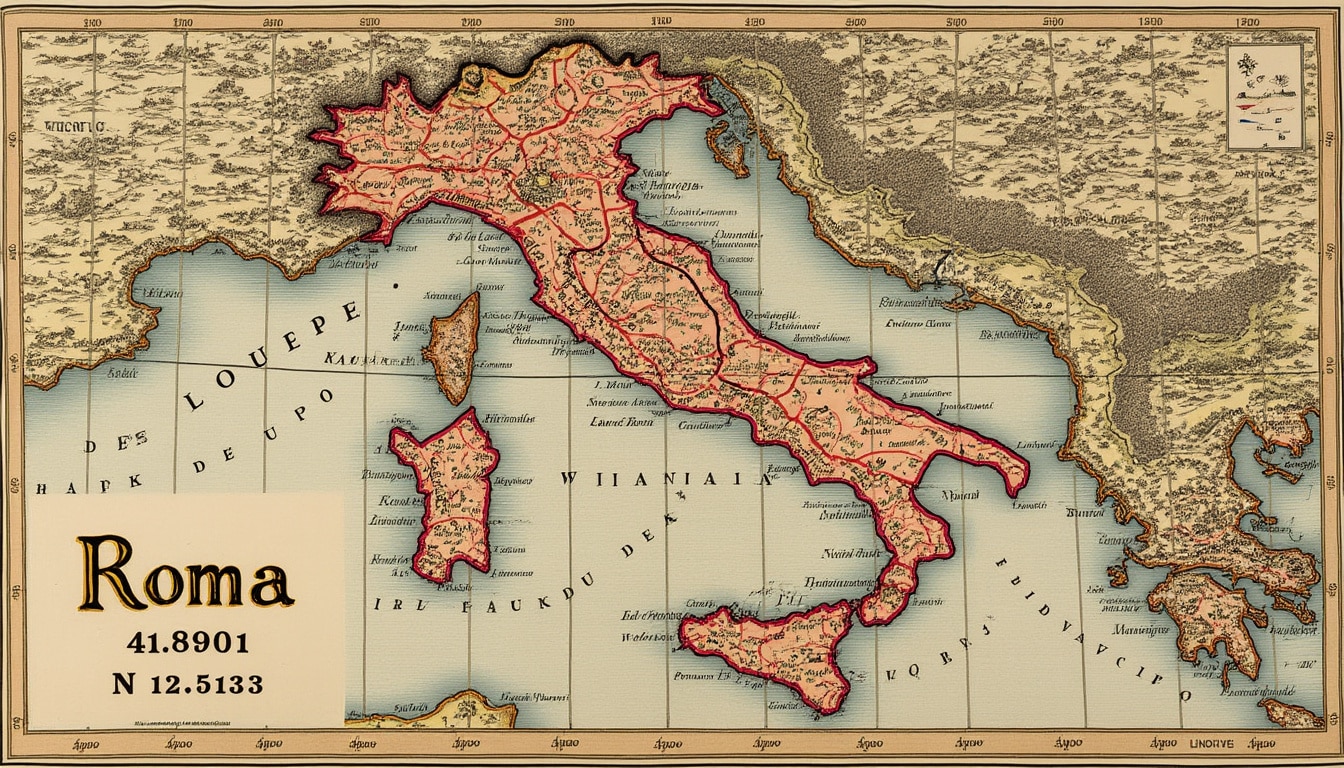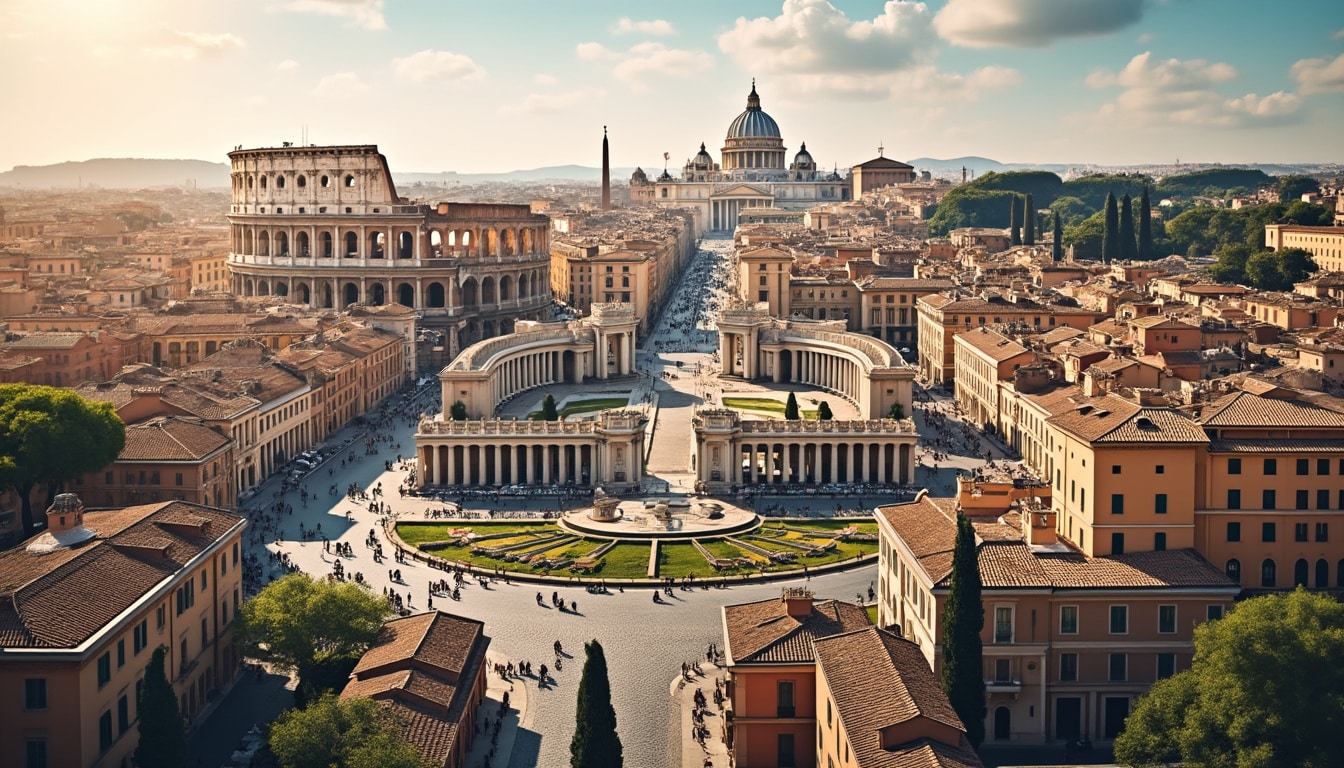In the bustling landscape of Italy, there lies a city that has endured the ebb and flow of time with grace and fortitude: Rome. The Eternal City, as it is often referred to, is not just a place on the map, but a living testament to thousands of years of human achievement, cultural shifts, and architectural feats. Nestled in central Italy’s Lazio region, Rome’s geographic position has played a crucial role in its historical and contemporary significance. Understanding Rome’s specific location is not merely an exercise in geographic precision, but an exploration of why this city continues to captivate millions of visitors and scholars alike.
Geographic Coordinates: Understanding Rome’s Exact Position
Rome, the capital of Italy, is located at a latitude of 41.89193° N and a longitude of 12.51133° E. These coordinates place Rome in the northern hemisphere and align it with other major global cities. Latitude, a geographic coordinate that specifies the north-south position of a point on the Earth’s surface, situates Rome in a mild Mediterranean climate with hot summers and cool winters. Longitude, the east-west position, aligns Rome with cities like Copenhagen, Denmark, and Leipzig, Germany.
These coordinates are part of the World Geodetic System 1984 (WGS84), which is the standard for cartography, geodesy, and navigation today. The use of geographic coordinates is essential for a variety of applications, from everyday navigation using apps like Google Maps and Waze to complex cartographic studies. This precision ensures that whether you’re booking a hotel via Booking.com or planning your itinerary on Rome2rio, you’ll always be guided accurately to Rome’s treasures.
Below is a table illustrating the geographic coordinates of Rome compared to other renowned global cities:
| City 🌍 | Latitude | Longitude |
|---|---|---|
| Rome, Italy | 41.89193° N | 12.51133° E |
| Chicago, USA | 41.85003° N | -87.65005° W |
| Barcelona, Spain | 41.38879° N | 2.15899° E |
| Istanbul, Turkey | 41.01384° N | 28.94966° E |
| Skopje, North Macedonia | 41.99646° N | 21.43141° E |
| Shenyang, China | 41.79222° N | 123.43278° E |
As evident from the table, Rome shares its latitude band with several other notable cities, creating a unique connection across different cultures and continents.

The Role of Geographic Coordinates in Rome’s Climate
The climatic conditions of Rome are heavily influenced by its location on the map. Sitting at a latitude that allows for the cozy embrace of Mediterranean weather, Rome enjoys relatively mild weather year-round. This delightful climate has made the city a year-round attraction, welcoming travelers who can walk through its ancient streets comfortably during most months.
This favorable climate, characterized by hot, dry summers and cool, wet winters, has historically facilitated agricultural productivity and human settlement since ancient times. The vineyards and olive groves that line the Roman outskirts are not just picturesque but also a nod to the city’s climatic advantages.
Rome’s Strategic Location in the Context of Europe
When considering Rome’s position in a European context, its geographic location has significant implications. Centrally situated within the Italian peninsula, Rome lies just 27 kilometers inland from the Tyrrhenian Sea in the central part of Italy. This strategic location allowed ancient Rome to grow from a small village into a massive empire that controlled land across Europe, North Africa, and parts of Asia.
Today’s Rome continues to benefit from its geographic position. It serves as a critical hub of political, economic, and cultural influence within Europe and the European Union. Being located relatively close to major European capitals like Paris, Berlin, and Madrid, Rome is easily accessible via various transportation networks. With companies like Skyscanner and Yelp, travelers can plan seamless trips, exploring flights and local experiences with ease.
Here is a list of Rome’s strategic advantages:
- 🏛️ Rome’s central location facilitated its rise as an empire hub.
- 🚆 Modern transportation networks enhance connectivity to and from Rome.
- 🗺️ Proximity to the Mediterranean Sea boosts maritime trade.
- 🛫 Major airports and extensive road networks support tourism and trade.
Rome’s rich tapestry of history combined with modern infrastructure paints a picture of how its geographic location remains as important now as it was centuries ago.
Environmental and Geographical Features of Rome
Rome is not only a city defined by its urban appeal but also by its natural surroundings. The city is situated on the central-western portion of the Italian Peninsula, along the shores of the Tiber River. The river itself is a vital aspect of Rome’s geography, running 406 kilometers and flowing into the Tyrrhenian Sea.
The hilly terrain surrounding Rome provides a backdrop of verdant landscapes, with the seven hills on which ancient Rome was built offering historical context and breathtaking views. These geographical features aren’t just aesthetic; they have affected the development patterns of the city over centuries.
Key geographical features include:
- 🌄 The Seven Hills of Rome: Aventine, Caelian, Capitoline, Esquiline, Palatine, Quirinal, and Viminal.
- 🌊 The Tiber River crossing the city.
- 🍃 The Aurelian Walls surrounding the city’s ancient core.
- ⛰️ Proximity to mountain ranges such as the Apennines.
These features not only form the city’s identity but are also explored in detail in travel guides like Lonely Planet, offering visitors intriguing insights into Rome’s natural dimensions.
Traveling to and Navigating within Rome
For those inspired to visit after learning about Rome’s remarkable geographic coordinates and location, planning your journey can be both thrilling and straightforward. Thanks to today’s digital aids, exploring Rome’s ancient streets and modern avenues is a rewarding experience for tourists and locals alike.
Travelers can leverage platforms such as Google Maps and TripAdvisor for guidance at each step of their journey. Whether arriving by air at Leonardo da Vinci International Airport or venturing into Rome’s historic sites, these tools ensure that landmarks are within easy reach. Airbnb and Booking.com offer accommodation options that allow visitors to stay immersed in the city’s vibrant culture.
Here are some travel tips:
- 🗺️ Use Google Maps for real-time navigation updates.
- 🚊 Purchase an ATAC ticket for unlimited access to public transit.
- 🏛️ Visit must-see landmarks via popular routes on Rome2rio.
- 📍 Plan dining experiences through reviews on Foursquare and TripAdvisor.
- ⚠️ Be aware of Rome’s local rules, including entry and criminal status, and geographic features.
Rome, with its unparalleled blend of history and geography, offers every traveler a chance to transport themselves through time while staying connected to the rhythms of modern Italy.
Insights on Local Navigation and Cultural Etiquette
Navigating Rome isn’t just about knowing the streets and avenues; understanding local customs and etiquette can greatly enhance one’s experience. While enjoying the sights, be mindful of local practices—this includes knowing the local drinking age restrictions and civic codes.
Additionally, while moving around, it’s worthwhile to respect the traditional ways the locals greet each other and show appreciation for Rome’s rich artistic heritage by observing common courtesies. Avoiding peak traffic times and using apps like Waze can also significantly enhance your travel comfort.
FAQs
Q1: What is the best time to visit Rome?
The best time to visit Rome is during the spring (April to June) or autumn (September to October) when the weather is pleasant and the tourist crowds are thinner.
Q2: Are there any geographical restrictions for exploring recreational areas in Rome?
No specific geographic restrictions, but certain areas might have regulations; check holiday openings and legal guidelines for safe exploration.
Q3: Can I navigate Rome using public transportation easily?
Yes, Rome’s comprehensive public transport system includes buses, trams, and the metro, making it easy to navigate using ATAC passes available at most transit stations.
Q4: How accessible are Rome’s coordinates for tourists planning online?
Rome’s coordinates are widely available through online maps and travel guides, ensuring easy navigation for tourists planning their itinerary digitally.

